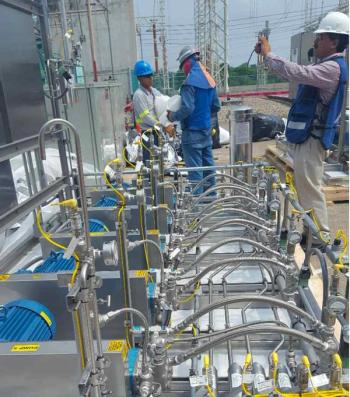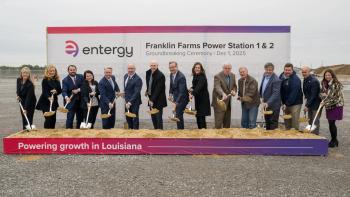
TURBOMACHINERY MARKET INNOVATION
Enrico Rebora, Ansaldo Energia’s Senior Vice President of Product and Plant Engineering, talks about new plant development, the latest combined cycle trends and turbine innovation.
In your role as a developer of plants, which types of facilities have tended to predominate over the last few years?
Until 2010, gas technologies reigned in Europe representing more than 30% of the total power generation market (about 40 GW/year). Since then, wind and solar PV have taken the place of gas technologies, and in the last year represented more than 70% of the power generation market.
In the U.S., gas and wind turbines are the winners in power generation, accounting for more than 75% in 2012. In Russia and the Middle East fossil fuels, mainly gas, represented more than 80% of the market.
North Africa is trending toward gas technologies with particular reference to open cycle technology, which in the last seven years totaled more than 30% of overall power generation. In developing Asian countries, cheaper coal is king (more than 60%) while gas is the first choice in Japan, Australia and South Korea. Latin America, on the other hand, has hydro in the lead.
Tell us about Ansaldo’s gas turbines
Our range of heavy duty gas turbines is composed of three main products from 75 to 310 MW in open cycle and up to 900 MW and 59% efficiency in combined cycle. Generally, customers who pay more attention to CAPEX when operating in emerging countries or where the cost of natural gas is cheap, tend to choose our E Class model AE94.2 (more than 185 MW and 36.2% efficiency). Those focusing more on OPEX in developed countries where natural gas is expensive tend to choose our F-class models AE64.3A and AE94.3A (75 MW and 35.9% efficiency and 310 MW and 39.8% efficiency, respectively).
We also recently entered the micro CHP business with the acquisition of Turbec’s business unit which specializes in design, manufacturing and installation of micro gas turbines. We envisage a 100kW and eventually a 600 kW micro gas turbine for several applications: energy efficiency (CHPCCHP), renewables (biomass, biogas and CSP solar applications), critical power supply (data centers and telecoms) and possibly oil and gas.
What are the latest developments in your gas turbine products?
Ansaldo Energia has undertaken a program to enhance performance and operational flexibility of its 3 GT models. Over the next three years, this will provide a roll out of upgraded models to our portfolio.
Recently, we used a customer site to successfully test an upgraded version of the AE94.3A4, our best seller in combined cycle plants. This comprised a new set of burners, a combustion chamber and features to enhance operating flexibility, and improve load ramp up and turndown capability.
Another round of tests is planned this year with a targeted turbine inlet temperature of 1,280°C, as well as a new compressor and turbine section being available by 2015 to provide an additional 35 MW and higher efficiency compared to the 2011 version.
For our AE 64.3A we have planned a bundle of enhancements (burners, combustion chamber and turbine section) to arrive at a power increase of 4% and higher efficiency by 2014. With respect to the E Class model, the AE 94.2, we have delivered several upgraded units over the last two years mainly related to burners and the combustion chamber. A new compressor section and turbine section, due in 2014, will deliver an additional 15 MW with greater efficiency compared to the 2011 version.
How is the steam turbine market?
The market has to be divided into three main segments: steam turbines for combined cycle and cogeneration applications; conventional thermal plant applications in supercritical or ultra-supercritical configurations (mainly fuelled by coal); and nuclear. Ansaldo can satisfy all of these segments.
The first segment is generally covered by steam turbines ranging from 50 to 350 MW. There is much demand for these low-to-medium-sized machines. The second segment is generally covered by steam turbines ranging from 350 to 650 MW, and there is a decent level of interest in these machines, but limited to specific areas (China, India and Chile represent more than 80% of the entire coal power generation market). The third segment is generally covered by steam turbines ranging over 1,000 MW, but requests are low due to the reduction in nuclear demand.
What factors are tending to drive the EPC market?
Being an EPC contractor is a quite bit different than being a simple machine provider. Our recent studies suggest that this market is very competitive because of the recent penetration of aggressive Asian players (mainly Korea) with low price strategies. It is also important to consider geographical segmentation. In general, success factors include price, MW range, delivery times, project references and being an OEM (such as, Ansaldo and Alstom).
What are the dominant trends and market drivers for O&M?
The global services market is a growing sector that offers steady revenues and solid growth, in contrast with the much more cyclical market for new-build power stations. The global service market will grow at a CAGR of 4.3% through 2017, to reach $35.4 billion (Source: Frost & Sullivan, 2011).
The key factors driving the power plant services market vary region by region. For Europe and North America, the drivers are aging power capacities that need lifetime extension or replacement and, linked to this, the growing adoption of gas-fired generation.
Moreover gas-fired plant services are generally associated with Long Term Service Agreements, where most maintenance is effectively outsourced.
For emerging markets, there is a preference for in-house maintenance, as Long- Term Service Agreements with OEMs are perceived to be expensive.
Newsletter
Power your knowledge with the latest in turbine technology, engineering advances, and energy solutions—subscribe to Turbomachinery International today.





